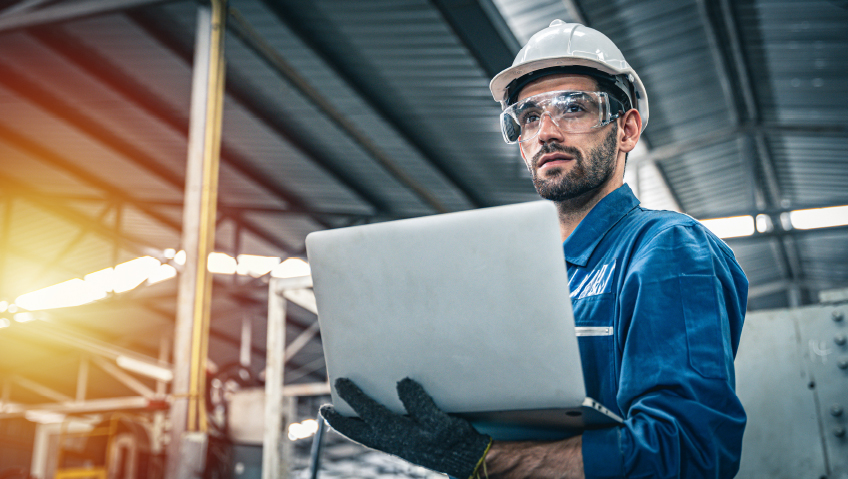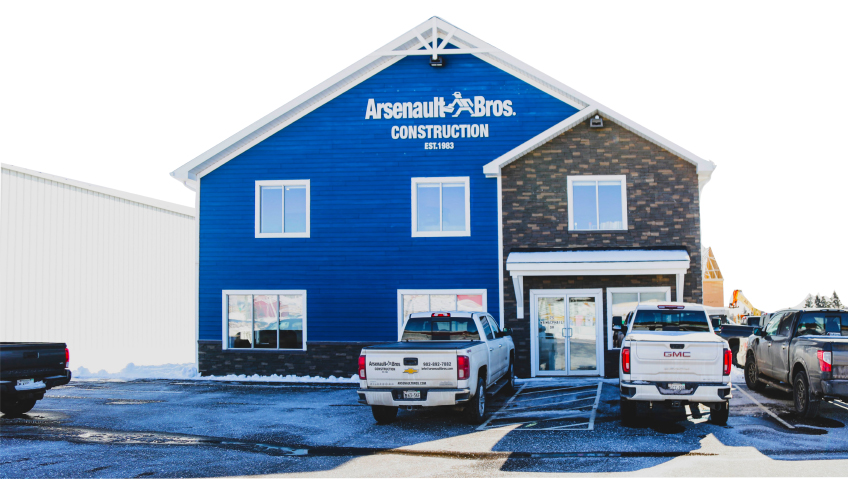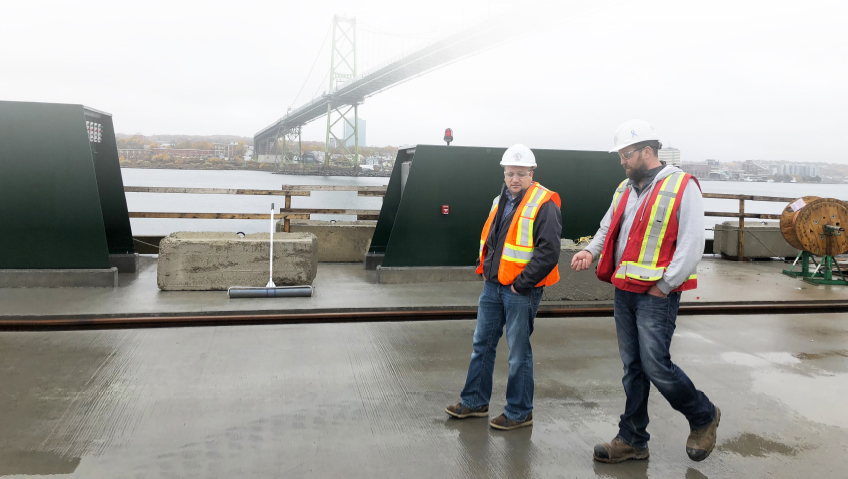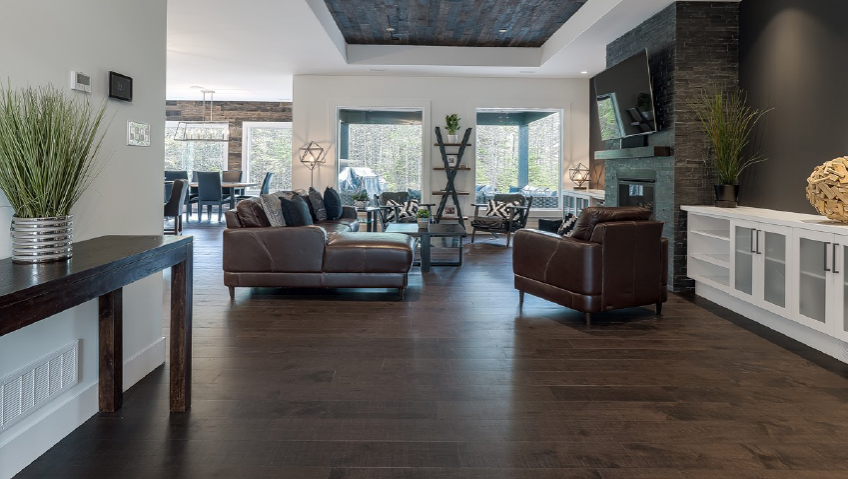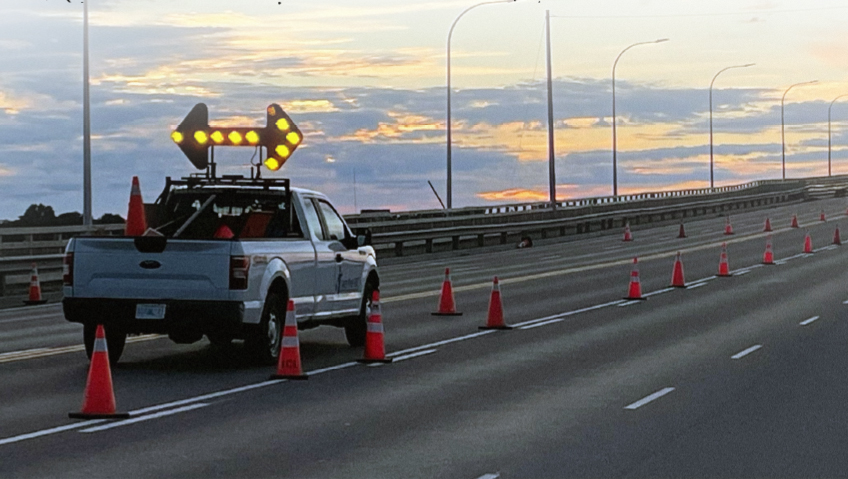Every year, construction-related accidents cost billions of dollars in lost wages and compensation, and thousands of lives worldwide. Fortunately, smart technologies and better materials are changing the safety game.
Despite Canada’s reputation as a nation of gentlefolk, our workforce-safety public service announcements (PSAs) rival Quentin Tarantino’s flicks for blood and gore. One of the earliest and most memorable series came from the Construction Safety Association of Ontario.
Airing in 1983, one spot shows a man hammering a brick wall with a metal chisel, helmet on, but no eye protection. An ominous male voiceover intones, “You know how much a piece of grit in the eye can hurt?” In slow motion, a sharp fragment flies into the worker’s face. “Imagine how a piece of metal like this can hurt the rest of your life? To work safely, you’ve got to have eye protection and proper tools. It takes know-how to prevent an accident. We’ve got it, let’s use it.”
As graphic as the commercial was, it paled compared to the Workplace Safety Insurance Board’s ‘There really are no accidents’ campaign in 2009. In one PSA, a welder high atop a building spoke to the camera about how he was working overtime so he could take his family on vacation. “But hey, I’m wearing a busted harness here,” he explains, “and the company should check those tanks to–” followed by an ear-shattering explosion and the welder’s mangled corpse flying off the building and landing on a truck.
Other spots are even more visceral, with a retail store employee falling off a wobbly ladder headfirst into a glass display case, a forklift driver being impaled by an avalanche of metal poles, and a young female chef slipping and dumping a pot of boiling oil on her face.
A similar WorkSafe commercial aired in Australia with the tagline, “It doesn’t hurt to speak up.”
Accidents, deaths still high
Everyone in construction has heard the phrase ‘accidents are preventable,’ and they mostly are. Tripping over a stray brick on the ground – why wasn’t it picked up? Receiving an electric shock from a power saw – why wasn’t the frayed power cord replaced?
There are plenty of ways to be injured on building sites, but the ‘fatal four’ – falling, electrocution, getting hit by an object, or being caught in equipment – can be life-altering, resulting in loss of limbs or cognitive function, or even death.
But even with workplace safety courses, construction safety officers, crews striving for zero incidents, the Occupational Safety and Health Administration (OSHA), the Canadian Centre for Occupational Health and Safety (CCOHS), the Canada Safety Council, and state and provincial safety bodies, accidents still happen.
A firm commitment from management combined with regular safety meetings, education, pre-planning, and ensuring everyone is on board from staff to subcontractors are all positive steps towards the goal of zero accidents.
To safeguard our body, there is full personal protective equipment (PPE) including hard hats, safety glasses, hearing protection, respirators, work gloves, high-visibility clothing, puncture and slip-resistant footwear with reinforced toecaps, and more.
Nevertheless, even with the right gear and safety protocols, there are hundreds of thousands of accidents worldwide every year. In 2020 in the United States, 1,008 construction workers lost their lives: 368 from falls, trips, or slips, 247 from transportation-related injuries, 174 through exposure to harmful substances or environments, and another 153 from contact with an object, or equipment.
Although this was a slight decrease from 2019’s 1,061 fatal construction work injuries, it is still far too high.
According to data from the U.S. Bureau of Labor Statistics Census of Fatal Occupational Injuries, construction keeps making the Top 25 list of the most dangerous professions in America.
Among the trades at greatest risk were roofers (with a fatal injury rate of 41 per 100,000 workers), ironworkers, crane operators, highway maintenance workers, cement masons, and construction workers, with falls being the most common cause of death.
Although construction workers in the U.S. comprise about six percent of the labour force, they account for 20 percent of worker deaths.
Wearable tech
Construction safety initiatives and gear have come a long way in the past century, when workers would be high atop buildings with minimal (if any) fall protection. Organizations such as the International Union of Ironworkers were created largely out of concern for the men performing dangerous work hundreds of feet in the air, connecting steel girders, and putting their lives at risk every day.
Primitive helmets of steamed canvas coated with glue and black paint were to follow, yet death and injury continued, especially on large projects. During the construction of San Francisco’s Golden Gate Bridge in the 1930s, it was expected that one worker would die for every million dollars spent.
Golden Gate Bridge’s chief engineer, Joseph Strauss, demanded that a safety net made from rope and mesh be installed below the bridge floor, which saved the lives of 19 workers.
Continuing to evolve, today’s construction equipment includes improved fall protection – required by the Occupational Safety and Health Administration (OSHA) at heights of six feet (1.8m.) or more, lighter ladders to reduce strain from lifting, and safety features on clutched drill motors and hand tools.
PPE picks up
Along with modifications to equipment, PPE has seen many improvements intended to boost worker safety. Old-fashioned PPE such as leather gloves are being replaced with plastic polymers like nitrile, which are lighter and stronger, and resist abrasion, cuts, punctures, and chemicals.
Alongside developments in PPE, safety in the construction sector is increasing thanks to Smartphone apps like the OSHA Heat Safety Tool, the Safesite Field app, and cloud-based technologies.
Building Information Modeling (BIM) has steadily gained momentum in architecture, engineering, and construction (AEC).
Describing BIM, American software giant Autodesk Inc. says it “is the holistic process of creating and managing information for a built asset. Based on an intelligent model and enabled by a cloud platform, BIM integrates structured, multi-disciplinary data to produce a digital representation of an asset across its lifecycle, from planning and design to construction and operations.”
Besides streamlining data, workflow, and teams, BIM offers many tools, including clash detection (hard clash, soft clash, and workflow clash). A hard clash reveals when two (or more) components in the same space interfere with one another through advanced 3D modeling.
As a benefit of ensuring that nothing is incompatible through thousands of algorithms, potential threats to safety – such as from falls – are also identified and highlighted. According to Autodesk, this “result of better decision-making” saw one contractor reduce site safety issues by 20 percent.
Other high-tech methods to improve safety include wearables like helmets, vests, and even exoskeletons connected wirelessly to the cloud. Unlike regular PPE, smartwatches, glasses, and other wearables are a hands-free means of communication and a safety game-changer.
Not only can these computerized devices detect falls (and alert emergency personnel), they can detect a spike in heart rate signalling overexertion, blood oxygen saturation, and even abnormal heart rhythms.
Safety from bottom to top
Literally making protection head-to-toe, the next generation of safety SmartBoots will do much more than protect workers from sharp or heavy objects by bringing the ability to detect shocks and falls, and even GPS and RFID to determine the worker’s exact location and collect data.
Charging kinetically as the worker moves around, boots from Pittsburgh-based SolePower also provide lighting, temperature sensing, and two-way communication.
Helmets, a long-time staple of construction safety, now offer more than external head protection. Through technology, some have sensor bands inside, which reveal proximity, alert workers to potential hazards, and even detect fatigue and microsleeps. Lasting less than 30 seconds, microsleeps can be dangerous – especially on construction sites with their many hazards.
By detecting those brief periods when our focus and concentration are reduced, these helmets let the worker know it is time for a break.
Much like helmets, construction ‘smart glasses’ are helping workers to stay safe. Smart glasses also provide augmented reality through computerized imagery, enabling workers to not only protect their eyesight but receive real-time information about potential hazards and how to avoid them.
From safety vests tracking the body temperature of workers to small clip-on devices detecting dangerous gases, construction safety keeps growing.

